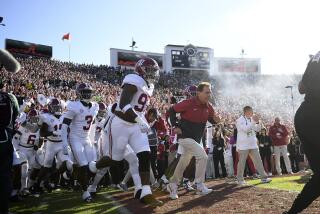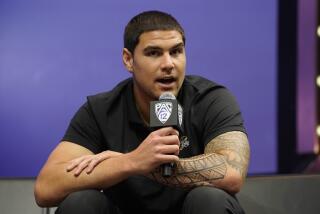College football, Greeks and other tales of alcohol abuse
- Share via
Alcohol policies surrounding football tailgating parties are common at many universities. Some schools ban alcohol at tailgating events entirely, others restrict alcohol to certain areas of the parking lots and others ban it during certain time periods, such as 30 minutes before kickoff. A new study shows that a majority of tailgaters were already well on their way to high blood-alcohol concentrations before the start of a college football game.
Researchers from the University of Toledo studied tailgaters at a large Midwest college football game. They gave Breathalyzer tests and surveys to 536 people age 18 to 83. The study found that 90% of the participants had consumed alcohol before the game and the average blood-alcohol concentration based on Breathalyzer was 0.06. The legal BAC limit for driving is 0.08.
Given that drinking may continue during the game and after the game, this amount of alcohol use before the game could be considered alarming. However, having designated areas where alcohol is allowed and is prohibited may cut down on excessive consumption, said the author of the study, Tavis Glassman. The research was presented Tuesday at the annual meeting of the American Public Health Assn.
In other alcohol-related news from the APHA meeting:
- Fraternities and sororities have reputations for heavy drinking -- and deservedly so. New numbers support that image and suggest that students in Greek-affiliated organizations on U.S. campuses may have substantially different alcohol-use patterns compared with non-Greek students. In addition, the alcohol consumption patterns among Greek-organization students suggest high rates of alcohol abuse among men and women.
Stuart Usdan of the University of Alabama surveyed 1,331 new Greek pledges on a large college campus. The students participated in surveys on their alcohol use and use among their peer group. The new pledges reported consuming an average of almost 18 drinks per week and 73% said they had engaged in binge drinking. More than two-thirds felt that most or nearly all of their close friends get drunk on a regular basis and 66.5% felt their close friends approved of getting drunk. “While first-year students represent a high-risk group for heavy drinking, they are surpassed by the excessive drinking behaviors of Greek-affiliated students,” Usdan wrote.
- Men begin drinking, on average, before women but women catch up when it comes to developing alcohol problems. A study by Johns Hopkins University researchers of 43,093 U.S. adults found that the average age of drinking onset was age 17.4 for women and 16.5 for men but the average age of developing alcohol dependence was about 24 for both. Whites and Hispanics developed alcohol dependence at younger ages than blacks.
- Alcohol taxes are highly influential when it comes to limiting the destruction caused by alcohol, said researchers from the University of Florida. They analyzed data from 50 studies that explored the impact of alcohol taxes and alcohol prices. The researchers concluded that doubling the alcohol tax would be associated, on average, with a 35% reduction in alcohol-related deaths, an 11% drop in traffic accident deaths, a 6% reduction in sexually transmitted diseases, a 2% decline in violence and a 1.4% drop in crime.
Return to Booster Shots blog.
More to Read
Go beyond the scoreboard
Get the latest on L.A.'s teams in the daily Sports Report newsletter.
You may occasionally receive promotional content from the Los Angeles Times.










